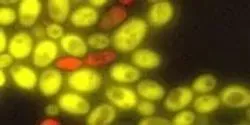Bacteria

North Carolina State University researchers have developed an effective and environmentally benign method to combat bacteria by engineering nanoscale particles that add the antimicrobial potency of silver to a core of lignin, a ubiquitous substance found in all plant cells. The findings introduce ideas for better, greener and safer nanotechnology and could lead to enhanced efficiency of antimicrobial products used in agriculture and personal care.

For centuries, humans have been playing with yeast. But these simple fungal cells usually do their jobs — making bread rise or converting sugar into alcohol — without having to communicate or work together.

Origami, the Japanese art of paper folding, can be used to create beautiful birds, frogs and other small sculptures. Now a Binghamton University engineer says the technique can be applied to building batteries, too.

Researchers at the University of Georgia have used a gene editing tool known as CRISPR/Cas to modify the genome of a tree species for the first time. Their research, published recently in the early online edition of the journal New Phytologist, opens the door to more rapid and reliable gene editing of plants.

Agricultural officials who seek to detect diseases affecting the commercial swine industry may gain a new ally — a biological detection system developed by Lawrence Livermore National Laboratory (LLNL) researchers.













